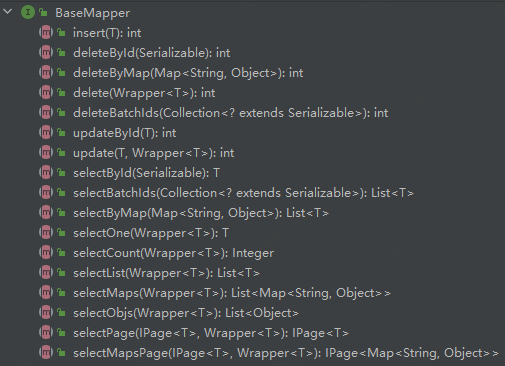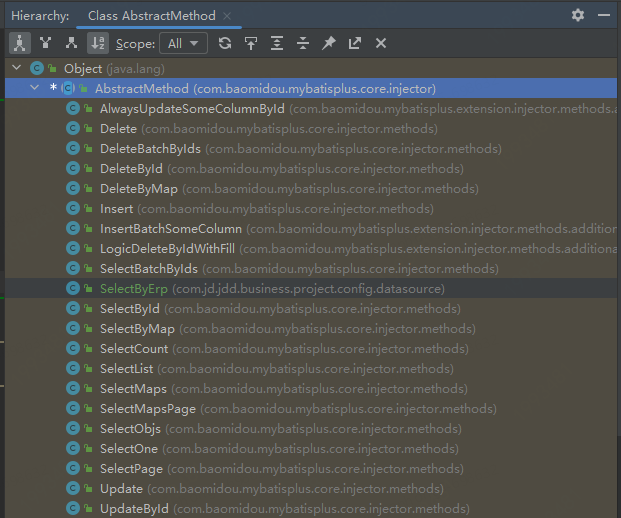手把手教你如何扩展(破解)mybatisplus的sql生成 | 京东云技术团队
最佳答案 问答题库748位专家为你答疑解惑
mybatisplus 的常用CRUD方法
众所周知,mybatisplus提供了强大的代码生成能力,他默认生成的常用的CRUD方法(例如插入、更新、删除、查询等)的定义,能够帮助我们节省很多体力劳动。
他的BaseMapper中定义了这些常用的CRUD方法,我们在使用时,继承这个BaseMapper类就默认拥有了这些能力。

如果我们的业务中,需要类似的通用Sql时,该如何实现呢?
是每个Mapper中都定义一遍类似的Sql吗?
显然这是最笨的一种方法。
此时我们可以借助mybatisplus这个成熟框架,来实现我们想要的通用Sql。
扩展常用CRUD方法
新增一个通用sql
比如有一个这样的需求,项目中所有表或某一些表,都要执行一个类似的查询,如`SelectByErp`,那么可以这样实现。(这是一个最简单的sql实现,使用时可以根据业务需求实现更为复杂的sql:比如多租户系统自动增加租户id参数、分库分表系统增加分库分表字段条件判断)
-
定义一个
SelectByErp类,继承AbstractMethod类,并实现injectMappedStatement方法 -
定义sql方法名、sql模板、实现sql的拼接组装
/*** 新增一个通用sql*/
public class SelectByErp extends AbstractMethod {// 需要查询的列名private final String erpColumn = "erp";// sql方法名private final String method = "selectByErp";// sql模板private final String sqlTemplate = "SELECT %s FROM %s WHERE %s=#{%s} %s";@Overridepublic MappedStatement injectMappedStatement(Class<?> mapperClass, Class<?> modelClass, TableInfo tableInfo) {// 获取需要查询的字段名及属性名TableFieldInfo erpFiled = getErpProperty(tableInfo);// 拼接组装sqlSqlSource sqlSource = new RawSqlSource(configuration, String.format(sqlTemplate,sqlSelectColumns(tableInfo, false),tableInfo.getTableName(), erpFiled.getColumn(), erpFiled.getProperty(),tableInfo.getLogicDeleteSql(true, false)), Object.class);return this.addSelectMappedStatementForTable(mapperClass, method, sqlSource, tableInfo);
}/*** 查询erp列信息*/private TableFieldInfo getErpProperty(TableInfo tableInfo) {List<TableFieldInfo> fieldList = tableInfo.getFieldList();TableFieldInfo erpField = fieldList.stream().filter(filed -> filed.getColumn().equals(erpColumn)).findFirst().get();return erpField;}
3.定义一个sql注入器GyhSqlInjector,添加SelectByErp对象
// 需注入到spring容器中
@Component
public class GyhSqlInjector extends DefaultSqlInjector { @Overridepublic List<AbstractMethod> getMethodList(Class<?> mapperClass) {List<AbstractMethod> methodList = super.getMethodList(mapperClass);// 增加 SelectByErp对象,程序启动后自动加载methodList.add(new SelectByErp());return methodList;}
}
4.定义一个基础MapperGyhBaseMapper,添加selectByErp方法
/*** 自定义的通用Mapper*/
public interface GyhBaseMapper<T> extends BaseMapper<T> {List<T> selectByErp(String erp);
}
5.应用中需要使用该SelectByErp方法的表,都继承GyhBaseMapper,那么这些表将都拥有了selectByErp这个查询方法,程序启动后会自动为这些表生成该sql。
public interface XXXMapper extends GyhBaseMapper<XXXTable>
添加一个mybatisplus已有sql
1.mybatisplus 常用CRUD方法如最上图,这些方法已经默认会自动生成,但mybatisplus其实提供了更多的方法,如下图,只要我们在启动时添加进去,就可以使用了。

2.比如我想使用AlwaysUpdateSomeColumnById方法,该方法可以在更新时只更新我需要的字段,不进行全字段更新。添加步骤如下。
3.定义一个sql注入器 ,如GyhSqlInjector,添加AlwaysUpdateSomeColumnById对象
@Component
public class GyhSqlInjector extends DefaultSqlInjector { @Overridepublic List<AbstractMethod> getMethodList(Class<?> mapperClass) {List<AbstractMethod> methodList = super.getMethodList(mapperClass);// 添加 AlwaysUpdateSomeColumnById 对象methodList.add(new AlwaysUpdateSomeColumnById());return methodList;}
}
4.定义一个基础Mapper 如GyhBaseMapper,添加alwaysUpdateSomeColumnById方法
/*** 自定义的通用Mapper*/
public interface GyhBaseMapper<T> extends BaseMapper<T> {int alwaysUpdateSomeColumnById(@Param(Constants.ENTITY) T entity);
}5.继承GyhBaseMapper的其他Mapper,将自动拥有alwaysUpdateSomeColumnById方法
/*** 自定义的通用Mapper*/
public interface GyhBaseMapper<T> extends BaseMapper<T> {int alwaysUpdateSomeColumnById(@Param(Constants.ENTITY) T entity);
}6.继承GyhBaseMapper的其他Mapper,将自动拥有alwaysUpdateSomeColumnById方法
编辑一个mybatisplus已有sql
1.如果想编辑一个mybatisplus已有sql,比如分库分表系统,执行updateById操作时,虽然主键Id已确定,但目标表不确定,此时可能导致该sql在多张表上执行,造成资源浪费,并且分库分表字段不可修改,默认的updateById不能用,需要改造。以下以shardingsphere分库分表为例。
2.定义一个UpdateByIdWithSharding类,继承UpdateById类
public class UpdateByIdWithSharding extends UpdateById {private String columnDot = "`";private YamlShardingRuleConfiguration yamlShardingRuleConfiguration;// 注入shardingsphere的分库分表配置信息public UpdateByIdWithSharding(YamlShardingRuleConfiguration yamlShardingRuleConfiguration) {this.yamlShardingRuleConfiguration = yamlShardingRuleConfiguration;}@Overridepublic MappedStatement injectMappedStatement(Class<?> mapperClass, Class<?> modelClass, TableInfo tableInfo) {String tableName = tableInfo.getTableName();// shardingsphere 分库分表配置信息Map<String, YamlTableRuleConfiguration> tables = yamlShardingRuleConfiguration.getTables();// 判断当前表是否设置了分表字段if (tables.containsKey(tableName)) {YamlTableRuleConfiguration tableRuleConfiguration = tables.get(tableName);// 获取分表字段String shardingColumn = tableRuleConfiguration.getTableStrategy().getStandard().getShardingColumn();// 构建sqlboolean logicDelete = tableInfo.isLogicDelete();SqlMethod sqlMethod = SqlMethod.UPDATE_BY_ID;// 增加分表字段判断String shardingAdditional = getShardingColumnWhere(tableInfo, shardingColumn);// 是否判断逻辑删除字段final String additional = optlockVersion() + tableInfo.getLogicDeleteSql(true, false);shardingAdditional = shardingAdditional + additional;String sql = String.format(sqlMethod.getSql(), tableInfo.getTableName(),getSqlSet(logicDelete, tableInfo, shardingColumn),tableInfo.getKeyColumn(), ENTITY_DOT + tableInfo.getKeyProperty(),shardingAdditional);SqlSource sqlSource = languageDriver.createSqlSource(configuration, sql, modelClass);return addUpdateMappedStatement(mapperClass, modelClass, sqlMethod.getMethod(), sqlSource);} else {return super.injectMappedStatement(mapperClass, modelClass, tableInfo);}}/*** where条件增加分表字段*/private String getShardingColumnWhere(TableInfo tableInfo, String shardingColumn) {StringBuilder shardingWhere = new StringBuilder();shardingWhere.append(" AND ").append(shardingColumn).append("=#{");shardingWhere.append(ENTITY_DOT);TableFieldInfo fieldInfo = tableInfo.getFieldList().stream().filter(f -> f.getColumn().replaceAll(columnDot, StringUtils.EMPTY).equals(shardingColumn)).findFirst().get();shardingWhere.append(fieldInfo.getEl());shardingWhere.append("}");return shardingWhere.toString();}/*** set模块去掉分表字段*/public String getSqlSet(boolean ignoreLogicDelFiled, TableInfo tableInfo, String shardingColumn) {List<TableFieldInfo> fieldList = tableInfo.getFieldList();// 去掉分表字段的set设置,即不修改分表字段String rmShardingColumnSet = fieldList.stream().filter(i -> ignoreLogicDelFiled ? !(tableInfo.isLogicDelete() && i.isLogicDelete()) : true).filter(i -> !i.getColumn().equals(shardingColumn)).map(i -> i.getSqlSet(ENTITY_DOT)).filter(Objects::nonNull).collect(joining(NEWLINE));return rmShardingColumnSet;}
}3.定义一个sql注入器GyhSqlInjector,添加UpdateByIdWithSharding对象
// 需注入到spring容器中
@Component
public class GyhSqlInjector extends DefaultSqlInjector { /*** shardingsphere 配置信息*/@Autowiredprivate YamlShardingRuleConfiguration yamlShardingRuleConfiguration;@Overridepublic List<AbstractMethod> getMethodList(Class<?> mapperClass) {List<AbstractMethod> methodList = super.getMethodList(mapperClass);// 添加 UpdateByIdWithSharding 对象,并注入分库分表信息methodList.add(new UpdateByIdWithSharding(yamlShardingRuleConfiguration));return methodList;}
}4.定义一个基础MapperGyhBaseMapper,添加新的selectById方法
/*** 自定义的通用Mapper*/
public interface GyhBaseMapper<T> extends BaseMapper<T> {int updateById(@Param(Constants.ENTITY) T entity);
}5.所有参与分表的表,在定义Mapper时继承GyhBaseMapper,那么在使用他的updateById方法时,将自动增加分库分表判断,准确命中目标表,减少其他分表查询的资源浪费。
以上是针对mybatisplus的一些简单改造,希望能为你提供一点点帮助~
作者:京东科技 郭艳红
来源:京东云开发者社区 转载请注明来源
99%的人还看了
相似问题
- Kotlin学习——kt里的集合,Map的各种方法之String篇
- Office文件在线预览大全-Word文档在线预览的实现方法-OFD文档在线预览-WPS文件在线预览
- composer切换全局镜像源的方法
- Python通过selenium调用IE11浏览器报错解决方法
- 测试用例的设计方法(全):正交实验设计方法|功能图分析方法|场景设计方发
- Java8新特性 ----- Lambda表达式和方法引用/构造器引用详解
- C#中抽象类、抽象方法和接口暨内联临时变量的精彩表达
- ChatGLM2 大模型微调过程中遇到的一些坑及解决方法(更新中)
- 类方法,静态方法和实例方法的区别及应用场景
- 【链表的说明、方法---顺序表与链表的区别】
猜你感兴趣
版权申明
本文"手把手教你如何扩展(破解)mybatisplus的sql生成 | 京东云技术团队":http://eshow365.cn/6-37201-0.html 内容来自互联网,请自行判断内容的正确性。如有侵权请联系我们,立即删除!